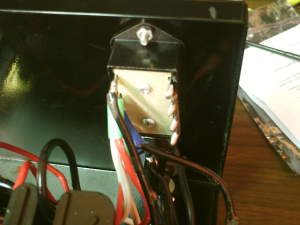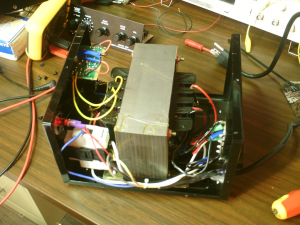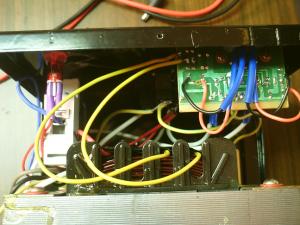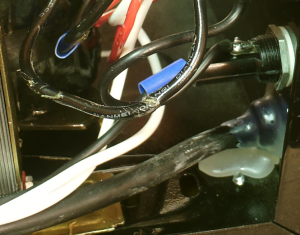Before I write any further, let’s agree on some nomenclature. For the sake of this article, I will use 220 Volts and 240 Volts interchangeably. In Europe, the correct supply voltage is 240 Volts AC. However, actual supply voltages range between 220 Volts and 240 Volts. Americans usually speak of “220” when referring to European voltages. Similarly, many Americans refer to their own supply voltage as 110 Volts even though it is actually rated at 120 Volts nominal. So again, for the sake of this article I will use 110 and 120 interchangeably.
I have a bunch of European equipment that works on 240 Volts only. Here in the US, I naturally only have 110 V available. While it is technically possible to combine two 110 Volt lines to create a 220 Volt line, I do not currently have that option to do so as my lab is fed by a single 110 V line only.
The solution to my problem is as simple as finding a 110 to 240 Volts transformer. If you have a power requirement of more than 1000 Watts, this can be a pretty expensive solution, though. Therefore, iIwas very surprised to find this 2000 W transformer for less than $100 [1]. For that price, I decided I’d give it a try.
There’s no actual magic inside the box. Inside the case is a standard transformer with a set of different primary taps.
According to the tech specs, this transformer will accept 110, 120, 220, and 240 Volts as input voltage. It supplies 110 Volts and 220 Volts on its output at the same time over two different receptacles.
I did measure 220 Volts output in actual working conditions with 110 Volts input. Accordingly, I could measure 240 Volts out with 120 Volts input while keeping the input selector set to “110 Volts.”
The transformer was pretty smelly at first. I assume this was the smell of the fresh paint. After airing it out for a few hours, it stopped smelling funny. The operation noise is barely audible and depends on the actual load.
The overall look of this transformer is pretty solid. The wiring has been done pretty well and the wires seem to have adequate thickness. The device is fused twice. There is a 20 A fuse on the primary side and another resettable 20 A fuse on the secondary side (220 V only). There are 2 spare primary fuses supplied with the transformer.
Just when I was about to close the transformer back up, I noticed a wire that looked a little bit suspicious. Have a look, do you see it?
The transformer works very well for my purpose. I have several SMD soldering tools and other scientific devices powered through this device. Most devices do not mind about the fact that the mains frequency is not being translated. European mains frequency is 50 Hz and in the USA it’s 60 Hz. Only devices which derive timing information from the mains frequency, like cheap alarm clocks for instance, will have difficulties dealing with the wrong frequency.
Links and Sources:
[1] Goldsource STU-2000, Amazon: http://www.amazon.com
Westerhold, S. (2013), "Review: Goldsource 2000 W Step Up & Down Transformer". Baltic Lab High Frequency Projects Blog. ISSN (Online): 2751-8140., https://baltic-lab.com/2013/01/review-goldsource-2000-w-step-up-down-transformer/, (accessed: October 22, 2025).
- WebP-Images without Plugin - January 14, 2025
- Firewall Rules with (dynamic) DNS Hostname - January 14, 2025
- Restoring proxied visitor IPs from Cloudflare - December 26, 2024





Confused Person
Hi. I wanted to know how to change fuses for Goldsource Transformer?
KF5OBS
There is a fuse on the back-side in the round fuse holder. Just remove the cap of the fuse holder by twisting it and remove the old fuse. Put a new fuse in and you’re done. Very simple and straight forward.
Annie
Hi, is this a transformer with a primary/secondary that offers isolation or an autotransformer arrangement?
Canadian who needs his coffee maker to work in Europe!
Great review – thanks!
I have this unit, and it was working great, until a faulty extension cord that I had plugged into the 110V output plug caused some slight melting of the 110V plug, and the circuit therefore no longer completes / there is no power coming out of the 110V output.
Any ideas where I can order a replacement 110V plug component, so that I can replace the faulty one?
Novy
how to fix goldsource electric converter. I did all right plugs, but it doesn’t work at all. The power light doesn’t flash.
Jeng
Would you recommend Goldsource or Panther? I need 150W only hehe
Annie
Good luck with a reply.
KF5OBS
I only ever used the Goldsource so I’d recommend that one for sure 🙂